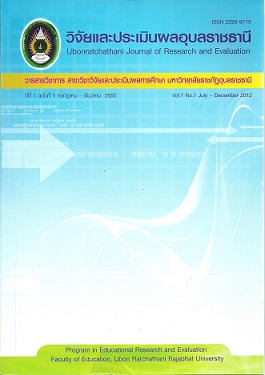The Operative Development of Analytic Reading Based on KWL-Plus Technique Used in Thai Unit for Prathom Suksa Four Students of Ban Pao School under the Jurisdiction of Ubon Ratchathani Primary Educational Service Area 1
Keywords:
ปฏิบัติการพัฒนาการอ่านเชิงวิเคราะห์ โดยใช้เทคนิค KWL – Plus,การอ่านเชิงวิเคราะห์,ภาษาไทยAbstract
The research aimed to study the operative development of analytic reading based on the technique KWL-Plus and the result of the development of an analytic reading based on the same technique for Prathom Suksa 4 students of Ban Pao School under the jurisdiction of Ubon Ratchathani Primary Educational Service Area 1 before and after the operation.
The samples in the research were 17 Prathom Suksa 4 (grade four) students enrolled in the first semester of the school year 2012. The research instruments were divided into two types: one was the instrument for the operation, that is, 24 KWL-plus based lesson plans and the other was the instrument used to gather data including the record format for the learning behavior, the record format for the teacher’s teaching behavior, interviews, daily record format, the lesson end exercises, the circle end learning achievement, achievement test, and analytic reading.
The techniques of the operation research consisted of three circles which were used to gather data. The researcher had conducted the achievement test of analytic reading, observed the reading operation through KWL-Plus based learning process, and learning behavior. Data derived from each circle were validated, interpreted and summarized so that improvement could be made in further operation. Qualitative data were validated and presented in a descriptive manner. Quantitative data were analyzed by using basic statistics and Nonparametric.
The research findings were as follows:
- The research had developed an analytic reading based on the technique known KWL-Plus. The process consisted of a pre-reading activity called K (what we know), a while learning activity called W (what we want to find out), a post-reading activity called L (what we have learned) and mapping. To learn about an analytic reading, students were divided into small groups for each plan; slow, moderate and fast learners were mixed. Each group was cooperative in studying and analyzed data as per the learning steps and summarized the results each group found. It was found that the learning process based on KWL-Plus contributed to the development of reading and analytic thinking, and encouraged the students to ask and seek the answers from what they had read. They were trained to systematize knowledge data and their relations from what they read by making a mapping. They developed the aim in reading and could utilize the analytic reading process to their daily life. Besides, their reading achievement improved.
- As regards the results of the operation, it was found that the students had 82.21 % of a reading achievement on average. 80% of them had passed the Considering the pre-and post-learning test, it was found that their learning achievement after the learning operation was higher than before learning at a statistical significance of .01.
References
ศิลปาบรรณาคาร, 2542.
ชลธิชา จันทร์แก้ว. การพัฒนาความสามารถด้านการอ่านเชิงวิเคราะห์ของนักเรียนชั้นประถมศึกษาปีที่ 6 ที่จัด
การเรียนรู้โดยใช้เทคนิค KWLH Plus. วิทยานิพนธ์ศึกษาศาสตรมหาบัณฑิต มหาวิทยาลัยศิลปากร, 2549.
ชัยยงค์ พรหมวงศ์และคนอื่นๆ. สื่อการสอนระดับประถมศึกษาเล่ม2. พิมพ์ครั้งที่ 4. นนทบรี: สำนักพิมพ์มหาวิทยาลัยสุโขทัยธรรมาธิราช, 2538.
ทิพสร มีปิ่น. การเปรียบเทียบความเข้าใจในการอ่านและเจตคติต่อการอ่านภาษาไทยของนักเรียนชั้นมัธยมศึกษาปีที่ 3 ที่เรียนโดยการสอนแบบปฏิสัมพันธ์ KWL-Plus กับการสอนอ่านตามคู่มือครู.ปริญญานิพนธ์การศึกษามหาบัณฑิต มหาวิทยาลัยศรีนครินทรวิโรฒ ประสานมิตร,2539.
ธีรวุฒิ เอกะกุล. การวิจัยปฏิบัติการ. พิมพ์ครั้งที่ 3. อุบลราชธานี: ยงสวัสดิ์อินเตอร์กรุ๊ปจำกัด, 2552.
บุญชม ศรีสะอาด. การวิจัยเบื้องต้น. พิมพ์ครั้งที่ 6. กรุงเทพฯ: สุวีริยาสาส์น, 2543.
ประภาพร ชัยป่ายาง. การพัฒนาความสามารถรู้ด้านการอ่านเชิงวิเคราะห์และเขียนสื่อความของนักเรียนชั้นประถมศึกษาปีที่ 3 ที่จัดการเรียนรู้โดยใช้เทคนิค KWL – Plus. วิทยานิพนธ์ศึกษาศาสตรมหาบัณฑิต มหาวิทยาลัยศิลปากร, 2549.
ประยงค์ ไชยขันธ์ . ได้ศึกษาการปฏิบัติการพัฒนาทักษะการอ่านอย่างมีวิจารณญาณของนักเรียนชั้นประถมศึกษาปีที่ 5. วิทยานิพนธ์ครุศาสตรมหาบัณฑิต มหาวิทยาลัยราชภัฏอุบลราชธานี, 2552.
ปิยะนุช ยืนสุข. การปฏิบัติการพัฒนาทักษะการเขียนคำที่มีสระลดรูป สำหรับนักเรียนชั้นประถมศึกษาปีที่ 3 .วิทยานิพนธ์ครุศาสตรมหาบัณฑิต มหาวิทยาลัยราชภัฏอุบลราชธานี, 2552.
มนภรณ์ ใจรอบรู้. การพัฒนาผลการเรียนรู้ด้านการอ่านเชิงวิเคราะห์ของนักเรียนชั้นประถมศึกษาปีที่ 4
ที่จัดการเรียนรู้โดยใช้เทคนิค KWL – Plus. วิทยานิพนธ์ศึกษาศาสตรมหาบัณฑิต มหาวิทยาลัยศิลปากร, 2551.
มารศรี ธานี. การปฏิบัติการเพื่อฝึกทักษะการอ่านและการเขียนภาษาไทยของนักเรียนชั้นประถมศึกษาปีที่ 2. วิทยานิพนธ์ครุศาสตรมหาบัณฑิต มหาวิทยาลัยราชภัฏอุบลราชธานี, 2549.
ล้วน สายยศและอังคณา สายยศ. เทคนิคการวิจัยทางการศึกษา. กรุงเทพฯ: สุวีริยาสาสน์, 2538.
วัชรา เล่าเรียนดี. เทคนิควิธีจัดการเรียนรู้สำหรับครูมืออาชีพ. กรุงเทพฯ: โครงการส่งเสริมการผลิตตำราและเอกสารการสอน คณะศึกษาศาสตร์ มหาวิทยาลัยศิลปากร วิทยาเขตพระราชวังสนามจันทร์,2547.
วิชาการ, กรม. พระราชบัญญัติการศึกษาแห่งชาติ พ.ศ. 2542. กรุงเทพฯ: โรงพิมพ์คุรุสภาลาดพร้าว, 2542.
. การวิจัยเพื่อพัฒนาการเรียนรู้. กรุงเทพฯ: โรงพิมพ์กรมการศาสนา, 2542.
. แนวการสอนภาษาไทย ชั้นประถมศึกษาปีที่ 4. กรุงเทพฯ: โรงพิมพ์องค์การรับส่งสินค้าและ
พัสดุภัณฑ์ (ร.ส.พ.),2544.
. การวิจัยเพื่อการพัฒนาการเรียนรู้ตามหลักสูตรสถานศึกษาขั้นพื้นฐาน. กรุงเทพฯ: โรงพิมพ์
คุรุสภาลาดพร้าว, 2545.
วิไลวรรณ สวัสดิวงศ์. การพัฒนาทักษะการอ่านอย่างมีวิจารณญาณ ของนักเรียนชั้นประถมศึกษาปีที่ 6 ที่จัด
การเรียนรู้ด้วยเทคนิค KWL-Plus. วิทยานิพนธ์ศึกษาศาสตรมหาบัณฑิต มหาวิทยาลัยศิลปากร, 2547.
ศศิพรรณ เปรื่องศิลปะรัตน์. การใช้รูปแบบ KWLA พัฒนาทักษะการอ่านและการเขียนนักเรียนชั้นประถมศึกษาปีที่ 4 โรงเรียนไทยนิยมสงเคราะห์. วิทยานิพนธ์ศิลปศาสตรมหาบัณฑิต มหาวิทยาลัยเกษตรศาสตร์, 2544.
ศึกษาธิการ, กระทรวง. พระราชบัญญัติการศึกษาแห่งชาติ พ.ศ. 2542 และที่แก้ไขเพิ่มเติม (ฉบับที่ 2) พ.ศ. 2545. กรุงเทพฯ: องค์การรับส่งสินค้าและพัสดุภัณฑ์, 2545.
. การจัดการเรียนรู้กลุ่มสาระการเรียนรู้ภาษาไทย. กรุงเทพฯ: โรงพิมพ์คุรุสภาลาดพร้าว, 2546.
. หลักสูตรแกนกลางการศึกษาขั้นพื้นฐาน พุทธศักราช 2551. กรุงเทพฯ: โรงพิมพ์ชุมนุมสหกรณ์การเกษตรแห่งประเทศไทย, 2551.
รับรองมาตรฐานและประเมินคุณภาพการศึกษา(องค์กรมหาชน), สำนักงาน. รายงานการประเมินคุณภาพภายนอกสถานศึกษาระดับการศึกษาขั้นพื้นฐาน รอบ 2 (พ.ศ. 2549 – 2553) โรงเรียนบ้านเป้า. กรุงเทพฯ: สำนักงานรับรองมาตรฐานและประเมินคุณภาพการศึกษา(องค์กรมหาชน), 2553.
สมนึก ภัททิยธนี. การประเมินผลการสร้างแบบทดสอบ. พิมพ์ครั้งที่ 3. กาฬสินธุ์: ประสานการพิมพ์ ,2537.
สุวิทย์ มูลคำ และอรทัย มูลคำ. 21 วิธีจัดการเรียนรู้เพื่อพัฒนากระบวนการคิด. กรุงเทพฯ: ห้างหุ้นส่วนจำกัด
ภาพพิมพ์, 2545.
เสาวลักษณ์ ตรองจิตร์. การพัฒนาแผนการเรียนรู้โดยใช้แบบฝึกทักษะการอ่านเชิงวิเคราะห์วิชาภาษาไทย
ชั้นประถมศึกษาปีที่ 5. วิทยานิพนธ์การศึกษามหาบัณฑิต มหาวิทยาลัยมหาสารคาม, 2547.
Downloads
Published
How to Cite
Issue
Section
License
1. บทความที่ตีพิมพ์ในวารสารนี้ได้มีการตรวจสอบการลอกเลียนงานวรรณกรรมแล้ว ไม่เกินร้อยละ 25
2. บทความที่ตีพิมพ์ในวารสารนี้เป็นข้อคิดเห็น ข้อค้นพบของผู้เขียนบทความ โดยผู้เขียนบทความต้องเป็นผู้รับผิดชอบต่อผลทางกฎหมายใด ๆ ที่อาจเกิดขึ้นจากบทความนั้น ๆ
3. บทความ ข้อมูล เนื้อหา รูปภาพ ฯลฯ ที่ได้รับการตีพิมพ์ในวารสารวิจัยและประเมินผลอุบลราชธานี ถือเป็นลิขสิทธิ์ของวารสารวิจัยและประเมินผลอุบลราชธานี หากบุคคลหรือหน่วยงานใดต้องการนำทั้งหมดไปเผยแพร่ต่อหรือเพื่อกระทำการใดๆ จะต้องได้รับอนุญาตเป็นลายลักษณ์อักษรจากวารสารวิจัยและประเมินผลอุบลราชธานีก่อนเท่านั้น และจะต้องมีการอ้างอิงวารสารวิจัยและประเมินผลอุบลราชธานี ฉบับนั้น ๆ ด้วย






